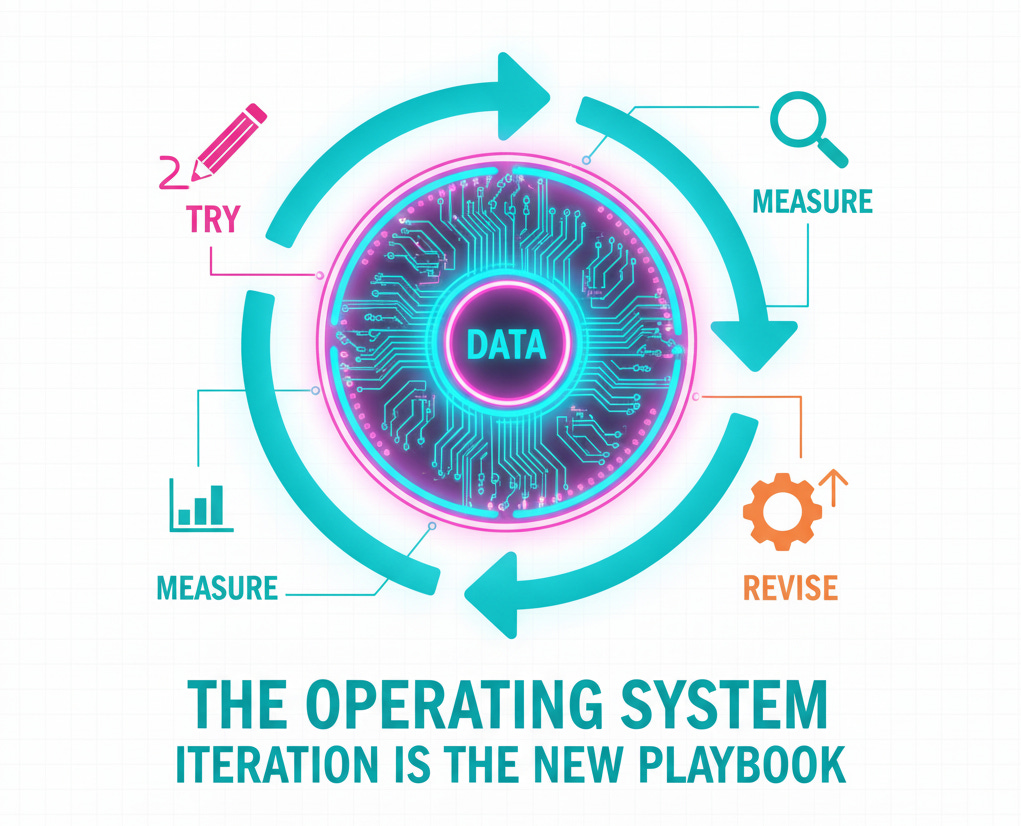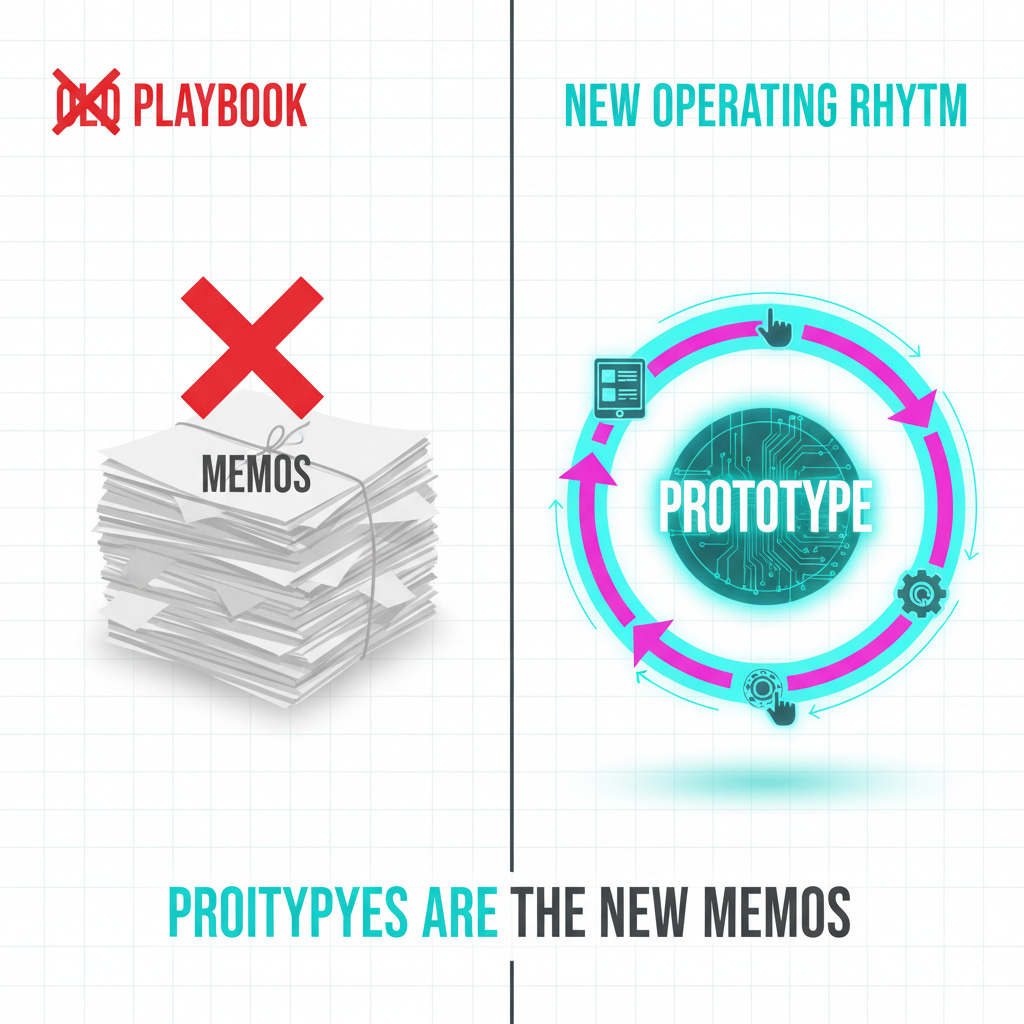Iteration Built This
Agentic AI is compressing the distance from idea to artifact.
My first vibecoded project took a week and felt like guessing in public. Six months later, I shipped a responsive, enterprise-quality portal in about an hour. Same chair, same coffee. The change wasn’t talent. It was mindset: treat every attempt as data, shorten the loop, and let momentum do the heavy lifting.
For decades, business rewarded process. We scaled by reducing variation, documenting every step, and moving work through orderly gates. That was the right playbook for the era of slow change and long planning cycles. But the ground has shifted. Markets move weekly. Customers expect upgrades, not memos. Competitors can prototype in a morning. In this environment, the advantage goes to leaders who learn faster than conditions change.
The mindset shift: from “get it perfect” to “learn in public”
Process still matters—but only if it serves learning speed. The new managerial craft is building a culture where people can try, measure, and revise without ceremony. Instead of asking for a master plan, ask for a small, provable next step. Instead of reviewing a slide deck, put a rough version in a user’s hands and watch what they do. Iteration isn’t a slogan; it’s the operating rhythm of modern work.
Velocity is a capability, not a mood. Short loops beat long debates.
Attempts become data. Data becomes better questions.
I didn’t become a software expert overnight. I simply learned to ask smaller, sharper questions. Early on, I’d ask for “a site that does everything.” Later, I defined one narrow success state a human could verify in three minutes. I started writing a brief “product requirement doc” that described behavior, not features. I named likely failure modes before a single screen was designed. The result wasn’t prettier because I tried harder; it was cleaner because the question was better.
Three practical pivots that compound:
Name the win clearly. One sentence. Anyone can check it.
Ship the smallest version. Not a presentation—an experience someone can touch.
Measure one thing that matters. Use that signal to write a better next question.
The better analogy: flight, not biology
Darwin’s loop—variation, selection, retention—captures the spirit of iteration. But the story I return to is flight. The Wright brothers didn’t craft a perfect plan and hope; they built a wind tunnel, ran instrumented tests, and iterated their way to control. They learned faster than anyone else because they created the conditions to learn. A century later, the same pattern shows up in modern aerospace and hardware: frequent test flights, lots of “shots on goal,” and the discipline to treat every failure as design input—not personal indictment. That’s the mindset leaders need now.
Build your wind tunnel (test harness). Fly often (release cadence). Read the gauges (metrics). Adjust the airframe (the design).
Why the old playbook stalls teams
Many large companies are still optimized for perfect plans and flawless approvals. Those habits worked when change arrived in predictable waves. They become liabilities when change is continuous. People learn to protect the plan instead of protecting the learning loop. Managers reward polish over progress. Meetings multiply while momentum disappears. None of this is about intelligence. It’s about incentives and fear—what looks safe in the short term can quietly destroy adaptability.
Meanwhile, agentic AI has collapsed the cost of trying. Drafts, mockups, prototypes, user flows—what took weeks now takes an afternoon. The cost of a test has fallen to near zero; the cost of not testing is compounding irrelevance.
What changed for me (and can change for you)
Somewhere between version three and version twelve, my loop shortened from days to hours. I treated the “product requirement doc” as a behavioral contract. I moved interface definitions and simple checks ahead of polish. I deleted elegant ideas that didn’t serve the goal. And I leaned into being a beginner—because humility is lighter to pivot than expertise you feel compelled to defend.
A minimal field checklist (use lightly, repeat often):
One page that defines the behavior you want (“done” in plain language).
A first version in 24–48 hours—something someone can use.
After release, capture three learnings, rewrite the top question, and go again.
The takeaway
Try. Don’t stop. In this economy, iteration isn’t a tactic; it’s the operating system. Attempts become data. Data becomes better questions. Better questions build the product—and the team. The loop is the permission slip. Keep going until your questions are so clear that the build assembles itself around them.
If you lead a team, set the expectation that prototypes are the new memos. Reward shipped learning, not slide-deck certainty. If you’re an individual, pick one problem you can scope to a 48-hour first version. Put it in front of a customer, measure one thing, and write down what you’ll do differently on the next loop.
Agentic AI will keep compressing the distance from idea to artifact. The companies—and careers—that thrive will be the ones that compress their learning loops to match. This scales. This works.



